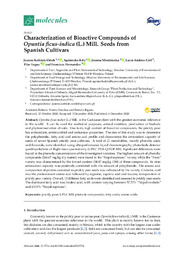Por favor, use este identificador para citar o enlazar este ítem:
https://hdl.handle.net/11000/36684
Characterization of Bioactive Compounds of Opuntia ficus-indica (L.) Mill. Seeds from Spanish Cultivars
Título :
Characterization of Bioactive Compounds of Opuntia ficus-indica (L.) Mill. Seeds from Spanish Cultivars |
Autor :
Kolniak-Ostek, Joanna 
Kita, Agnieszka 
Miedzianka, Joanna 
Andreu Coll, Lucía 
Legua, Pilar 
Hernández, Francisca |
Editor :
MDPI |
Departamento:
Departamentos de la UMH::Producción Vegetal y Microbiología |
Fecha de publicación:
2020-12-04 |
URI :
https://hdl.handle.net/11000/36684 |
Resumen :
Opuntia ficus-indica (L.) Mill. is the Cactaceae plant with the greatest economic relevance in the world. It can be used for medicinal purposes, animal nutrition, production of biofuels and phytoremediation of soils. Due to its high content of bioactive compounds, the prickly pear has antioxidant, antimicrobial and anticancer properties. The aim of this study was to determine the polyphenolic, fatty acid and amino acid profile and characterize the antioxidant capacity of seeds of seven Spanish prickly pear cultivars. A total of 21 metabolites, mainly phenolic acids and flavonols, were identified using ultraperformance liquid chromatography photodiode detector quadrupole/time-of-flight mass spectrometry (UPLC-PDA-Q/TOF-MS). Significant differences were found in the phenolic concentrations of the investigated varieties. The highest amount of phenolic compounds (266.67 mg/kg dry matter) were found in the “Nopal espinoso” variety, while the “Fresa” variety was characterized by the lowest content (34.07 mg/kg DM) of these compounds. In vitro antioxidant capacity was positively correlated with the amount of polyphenols. The amino acid composition of protein contained in prickly pear seeds was influenced by the variety. Glutamic acid was the predominant amino acid followed by arginine, aspartic acid and leucine, independent of prickly pear variety. Overall, 13 different fatty acids were identified and assessed in prickly pear seeds. The dominant fatty acid was linoleic acid, with content varying between 57.72% “Nopal ovalado” and 63.11% “Nopal espinoso”
|
Palabras clave/Materias:
Prickly pear
UPLC-MS
Phenolic compounds
Fatty acids
Amino acids |
Tipo de documento :
info:eu-repo/semantics/article |
Derechos de acceso:
info:eu-repo/semantics/openAccess
Attribution-NonCommercial-NoDerivatives 4.0 Internacional |
DOI :
https://doi.org/10.3390/molecules25235734 |
Aparece en las colecciones:
Artículos - Producción vegetal y microbiología
|
 La licencia se describe como: Atribución-NonComercial-NoDerivada 4.0 Internacional.
La licencia se describe como: Atribución-NonComercial-NoDerivada 4.0 Internacional.
 La licencia se describe como: Atribución-NonComercial-NoDerivada 4.0 Internacional.
La licencia se describe como: Atribución-NonComercial-NoDerivada 4.0 Internacional.
.png)
